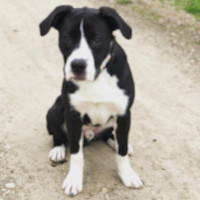Appearance of the Boxollie
|
| Hybrid breeds tend to vary in appearance even within the same litter. The Boxollie generally resembles the Boxer in appearance. Its dense coat varies from short to medium and is water repellent. Color combinations range from black to brown to white. The Boxollie's build can vary from medium to large, depending on the dominant traits it inherits. This athletic breed exudes intelligence and intelligent expression. Its posture contains a muscular essence. Its symmetrical body is proportionate to its body. The tail is generally left natural in the Boxollie. The breed's weight varies from 20.5 to 36 kilos and measures 46 to 63.5 centimeters. |
Temperament of the Boxollie
|
| The Boxollie's energy levels are moderate. Daily exercise is necessary to maintain a healthy weight and provide mental stimulation. This breed will like to keep busy, but will also enjoy spending time with you sitting and relaxing. It likes to be around others and enjoys being able to play. Early training should be provided to teach the Boxollie foreign friends and other animals. The Boxollie may show hesitant behavior towards other dogs and small animals due to its initial goal of catching prey. Loving children, this playful breed will enjoy having children to run and play with as long as boundaries are established. Positive reinforcement techniques are recommended for this breed. Firm commands are more likely to be respected. Because of its intelligence, the Boxollie learns quickly and repetition will most likely be unnecessary. |
Needs and activities of the Boxollie
|
| The Boxollie has moderate energy levels compared to other dogs. Exercise sessions should last between 30 and 40 minutes a day to ensure your dog gets the right amount every day. Some activities your dog may enjoy are walking, running and retrieving. Apartment living can work if the breed has outdoor access for walking or strolling in a fenced yard. An ideal environment for the Boxollie would be a medium-sized rural home with a fenced yard in a warm climate. An urban environment would also work as long as your hybrid has the appropriate exercise. This breed would not do well in a cold climate. |
Maintenance of the Boxollie
|
| The Boxollie is not a hypoallergenic breed and throws moderately compared to other breeds. Daily brushing should be supplemented with a rubber curry brush if the coat is short. If the coat is closer to medium length, a firm bristle brush and comb would work best to remove tangles and keep the coat spotless. If your dog has feathers on its legs, a light trim can be done by a professional groomer. This breed is not known for drooling or possessing strong odors, so there's no need to bathe him so often. Ears, nails and teeth will also need proper attention. Ears should be checked weekly for dirt and wax. Teeth may need daily brushing and generally, nails should be trimmed every two weeks, unless they are wearing naturally. In that case, monthly clippings may suffice. |









 English (United Kingdom)
English (United Kingdom)